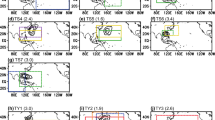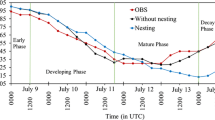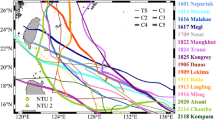Abstract
Recent studies found that in the context of global warming, the observed tropical cyclones (TCs) exhibit significant poleward migration trend in terms of the mean latitude where TCs reach their lifetime-maximum intensity in the western North Pacific (WNP). This poleward migration of TC tracks can be attributed to not only anthropogenic forcing (e.g., continuous increase of sea surface temperature (SST)), but also impacts of other factors (e.g., natural variability). In the present study, to eliminate the impacts of other factors and thus focus on the impact of unvaried SST on climatological WNP TC tracks, the mesoscale Weather Research and Forecasting (WRF) model is used to conduct a suite of idealized sensitivity experiments with increased SST. Comparisons among the results of these experiments show the possible changes in climatological TC track, TC track density, and types of TC track in the context of SST increase. The results demonstrate that under the warmer SST conditions, the climatological mean TC track systematically shifts poleward significantly in the WNP, which is consistent with the previous studies. Meanwhile, the ocean warming also leads to the decreased (increased) destructive potential of TCs in low (middle) latitudes, and thus northward migration of the region where TCs have the largest impact. Further results imply the possibility that under the ocean warming, the percentage of TCs with westward/northwestward tracks decreases/increases distinctly.
Similar content being viewed by others
References
Bell, M. M., and M. T. Montgomery, 2008: Observed structure, evolution, and potential intensity of category 5 Hurricane Isabel (2003) from 12 to 14 September. Mon. Wea. Rev., 136, 2023–2046, doi: 10.1175/2007MWR1858.1.
Camargo, S. J., 2013: Global and regional aspects of tropical cyclone activity in the CMIP5 models. J. Climate, 26, 9880–9902, doi: 10.1175/JCLI-D-12-00549.1.
Camargo, S. J., A. G. Barnston, and S. E. Zebiak, 2005: A statistical assessment of tropical cyclone activity in atmospheric general circulation models. Tellus, 57, 589–604, doi: 10.3402/tellusa.v57i4.14705.
Cox, P. M., R. A. Betts, C. D. Jones, et al., 2000: Acceleration of global warming due to carbon-cycle feedbacks in a coupled climate model. Nature, 408, 184–187, doi: 10.1038/35041539.
Dudhia, J., 1989: Numerical study of convection observed during the winter monsoon experiment using a mesoscale twodimensional model. J. Atmos. Sci., 46, 3077–3107, doi: 10.1175/1520-0469(1989)046<3077:NSOCOD>2.0.CO;2.
Elsner, J. B., 2003: Tracking hurricanes. Bull. Amer. Meteor. Soc., 84, 353–356, doi: 10.1175/BAMS-84-3-353.
Elsner, J. B., J. C. Trepanier, S. E. Strazzo, et al., 2012: Sensitivity of limiting hurricane intensity to ocean warmth. Geophys. Res. Lett., 39, 17702, doi: 10.1029/2012GL053002.
Emanuel, K., 2000: A statistical analysis of tropical cyclone intensity. Mon. Wea. Rev., 128, 1139–1152, doi: 10.1175/1520-0493(2000)128<1139:ASAOTC>2.0.CO;2.
Emanuel, K. A., 1986: An air–sea interaction theory for tropical cyclones. Part I: Steady-state maintenance. J. Atmos. Sci., 43, 585–605, doi: 10.1175/1520-0469(1986)043<0585:AASITF> 2.0.CO;2.
Emanuel, K., R. Sundararajan, and J. Williams, 2008: Hurricanes and global warming: Results from downscaling IPCC AR4 simulations. Bull. Amer. Meteor. Soc., 89, 347–368, doi: 10.1175/BAMS-89-3-347.
Grell, G. A., and D. Dévényi, 2002: A generalized approach to parameterizing convection combining ensemble and data assimilation techniques. Geophys. Res. Lett., 29, 587–590, doi: 10.1029/2002GL0153.
Henderson-Sellers, A., H. Zhang, G. Berz, et al., 1998: Tropical cyclones and global climate change: A post-IPCC assessment. Bull. Amer. Meteor. Soc., 79, 19–38, doi: 10.1175/1520-0477(1998)079<0019:TCAGCC>2.0.CO;2.
Holland, G. J., 1997: The maximum potential intensity of tropical cyclones. J. Atmos. Sci., 54, 2519–2541, doi: 10.1175/1520-0469(1997)054<2519:TMPIOT>2.0.CO;2.
Hong, S.-Y., 2010: A new stable boundary-layer mixing scheme and its impact on the simulated East Asian summer monsoon. Quart. J. Roy. Meteor. Soc., 136, 1481–1496, doi: 10.1002/Qj.665.
Hong, S.-Y., H.-M. H. Juang, and Q. Y. Zhao, 1998: Implementation of prognostic cloud scheme for a regional spectral model. Mon. Wea. Rev., 126, 2621–2639, doi: 10.1175/1520-0493 (1998)126<2621:IOPCSF>2.0.CO;2.
Hong, S.-Y., Y. Noh, and J. Dudhia, 2006: A new vertical diffusion package with an explicit treatment of entrainment processes. Mon. Wea. Rev., 134, 2318–2341, doi: 10.1175/Mwr3199.1.
Kim, J.-H., C.-H. Ho, H.-S. Kim, et al., 2012: 2010 western North Pacific typhoon season: Seasonal overview and forecast using a track-pattern-based model. Wea. Forecasting, 27, 730–743, doi: 10.1175/waf-d-11-00109.1.
Knapp, K. R., M. C. Kruk, D. H. Levinson, et al., 2010: The international best track archive for climate stewardship (IBTrACS): Unifying tropical cyclone data. Bull. Amer. Meteor. Soc., 91, 363–376, doi: 10.1175/2009BAMS2755.1.
Knutson, T. R., 2010: Tropical cyclones and climate change: An Indian Ocean perspective. Indian Ocean Tropical Cyclones and Climate Change, Y. Charabi, Ed., Springer, Dordrecht, 47–49, doi: 10.1007/978-90-481-3109-9_7.
Kossin, J. P., K. A. Emanuel, and G. A. Vecchi, 2014: The poleward migration of the location of tropical cyclone maximum intensity. Nature, 509, 349–352, doi: 10.1038/nature13278.
Kossin, J. P., K. A. Emanuel, and S. J. Camargo, 2016: Past and projected changes in western North Pacific tropical cyclone exposure. J. Climate, 29, 5725–5739, doi: 10.1175/JCLI-D-16-0076.1.
Lau, K.-M., and H. Y. Weng, 1999: Interannual, decadal–interdecadal, and global warming signals in sea surface temperature during 1955–97. J. Climate, 12, 1257–1267, doi: 10.1175/1520-0442(1999)012<1257:IDIAGW>2.0.CO;2.
Lau, W. K. M., J. J. Shi, W. K. Tao, et al., 2016: What would happen to superstorm Sandy under the influence of a substantially warmer Atlantic Ocean? Geophys. Res. Lett., 43, 802–811, doi: 10.1002/2015GL067050.
Li, T., M. H. Kwon, M. Zhao, et al., 2010: Global warming shifts Pacific tropical cyclone location. Geophys. Res. Lett., 37, L21804, doi: 10.1029/2010GL045124.
MacQueen, J., 1967: Some methods for classification and analysis of multivariate observations. Fifth Berkeley Symposium on Mathematical Statistics and Probability, Berkeley, CA, 16 January, University of California Press, 281–297
Mann, H. B., and D. R. Whitney, 1947: On a test of whether one of two random variables is stochastically larger than the other. Ann. Math. Statist., 18, 50–60, doi: 10.1214/aoms/1177730491.
Mlawer, E. J., S. J. Taubman, P. D. Brown, et al., 1997: Radiative transfer for inhomogeneous atmospheres: TMRR, a validated correlated-k model for the longwave. J. Geophys. Res. Atmos., 102, 16663–16682, doi: 10.1029/97JD00237.
Nakamura, J., U. Lall, Y. Kushnir, et al., 2009: Classifying North Atlantic tropical cyclone tracks by mass moments. J. Climate, 22, 5481–5494, doi: 10.1175/2009JCLI2828.1.
Nakamura, J., S. J. Camargo, A. H. Sobel, et al., 2017: Western North Pacific tropical cyclone model tracks in present and future climates. J. Geophys. Res. Atmos., 122, 9721–9744, doi: 10.1002/2017JD027007.
Strazzo, S., J. B. Elsner, J. C. Trepanier, et al., 2013a: Frequency, intensity, and sensitivity to sea surface temperature of North Atlantic tropical cyclones in best-track and simulated data. J. Adv. Model. Earth Syst., 5, 500–509, doi: 10.1002/jame. 20036.
Strazzo, S., J. B. Elsner, T. LaRow, et al., 2013b: Observed versus GCM-generated local tropical cyclone frequency: Comparisons using a spatial lattice. J. Climate, 26, 8257–8268, doi: 10.1175/JCLI-D-12-00808.1.
Sugi, M., H. Murakami, and J. Yoshimura, 2009: A reduction in global tropical cyclone frequency due to global warming. Sci. Online Lett. Atmos., 5, 164–167, doi: 10.2151/sola.2009-042.
Sun, Y., Z. Zhong, L. Yi, et al., 2015a: Dependence of the relationship between the tropical cyclone track and western Pacific subtropical high intensity on initial storm size: A numerical investigation. J. Geophys. Res. Atmos., 120, 11451–11467, doi: 10.1002/2015JD023716.
Sun, Y., Z. Zhong, H. Dong, et al., 2015b: Sensitivity of tropical cyclone track simulation over the western North Pacific to different heating/drying rates in the Betts–Miller–Janjić scheme. Mon. Wea. Rev., 143, 3478–3494, doi: 10.1175/MWR-D-14-00340.1.
Sun, Y., Z. Zhong, T. Li, et al., 2017a: Impact of ocean warming on tropical cyclone track over the western North Pacific: A numerical investigation based on two case studies. J. Geophys. Res., 122, 8617–8630, doi: 10.1002/2017JD026959.
Sun, Y., Z. Zhong, T. Li, et al., 2017b: Impact of ocean warming on tropical cyclone size and its destructiveness. Sci. Rep., 7, 8154, doi: 10.1038/s41598-017-08533-6.
Tonkin, H., C. Landsea, G. J. Holland, et al., 1997: Tropical cyclones and climate change: A preliminary assessment. Assessing Climate Change: Results from the Model Evaluation Consortium for Climate Assessment, W. Howe and A. Henderson-Sellers, Eds., Gordon and Breach, Sydney, 327–360
Tsutsui, J., and A. Kasahara, 2000: The role of cumulus schemes in the reproducibility of tropical cyclones by the NCAR Community Climate Model (CCM3). Preprints, 24th Conf. on Hurricanes and Tropical Meteorology, Fort Lauderdale, FL, Amer. Meteor. Soc., 350–351
Ueno, M., and J. Yoshimura, 2002: Impact of physical processes in a GCM on the frequency of tropical cyclones. WGNE Blue Book 2002: Research Activities in Atmospheric and Oceanic Modelling, WMO/TD-No. 1105, 0429–0430
Vitart, F., J. L. Anderson, J. Sirutis, et al., 2001: Sensitivity of tropical storms simulated by a general circulation model to changes in cumulus parametrization. Quart. J. Roy. Meteor. Soc., 127, 25–51, doi: 10.1002/qj.49712757103.
Wang, Y. X., Y. Sun, Q. F. Liao, et al., 2017: Impact of initial storm intensity and size on the simulation of tropical cyclone track and western Pacific subtropical high extent. J. Meteor. Res., 31, 946–954, doi: 10.1007/s13351-017-7024-3.
Webster, P. J., G. J. Holland, J. A. Curry, et al., 2005: Changes in tropical cyclone number, duration, and intensity in a warming environment. Science, 309, 1844–1846, doi: 10.1126/science. 1116448.
Wu, L. G., and B. Wang, 2004: Assessing impacts of global warming on tropical cyclone tracks. J. Climate, 17, 1686–1698, doi:1 0.1175/1520-0442(2004)017<1686:AIOGWO>2.0.CO;2.
Wu, L. G., B. Wang, and S. Q. Geng, 2005: Growing typhoon influence on East Asia. Geophys. Res. Lett., 32, L18703, doi: 10.1029/2005GL022937.
Ying, M., E.-J. Cha, and H. J. Kwon, 2011: Comparison of three western North Pacific tropical cyclone best track datasets in a seasonal context. J. Meteor. Soc. Japan, 89, 211–224, doi: 10.2151/jmsj.2011-303.
Yoshimura, J., M. Sugi, and A. Noda, 2006: Influence of greenhouse warming on tropical cyclone frequency. J. Meteor. Soc. Japan, 84, 405–428, doi: 10.2151/jmsj.84.405.
Yu, J. H., Y. Q. Zheng, Q. S. Wu, et al., 2016: K-means clustering for classification of the northwestern Pacific tropical cyclone tracks. J. Trop. Meteor., 22, 127–135, doi: 10.16555/j.1006-8775.2016.02.003.
Author information
Authors and Affiliations
Corresponding author
Additional information
Supported by the National Natural Science Foundation of China (41430426 and 41605072) and Natural Science Foundation of Jiangsu (BK20160768).
Rights and permissions
About this article
Cite this article
Shen, Y., Sun, Y., Zhong, Z. et al. Sensitivity Experiments on the Poleward Shift of Tropical Cyclones over the Western North Pacific under Warming Ocean Conditions. J Meteorol Res 32, 560–570 (2018). https://doi.org/10.1007/s13351-018-8047-0
Received:
Accepted:
Published:
Issue Date:
DOI: https://doi.org/10.1007/s13351-018-8047-0




